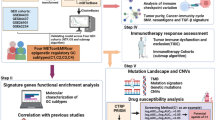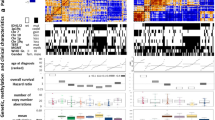Abstract
Objective
Epigenetic tumor features are getting into focus as prognostic markers in glioblastoma. Whether intra-tumoral heterogeneity in these epigenetic characteristics may influence prognostic value remains unclear.
Methods
Of 154 patients suffering from glioblastoma, 120 patients served as reference collective, while 34 patients were compiled as test collective. MGMT, p15, and p16 promoter methylation and miRNA expression levels (miRNA-21, miRNA-24, miRNA-26a, and miRNA-181d) were measured in each tumor specimen. Serving as a statistical baseline, epigenetic heterogeneity between tumors (inter-tumoral) was estimated within a triplet of three tumor specimens from three different reference patients. For estimation of epigenetic heterogeneity within a tumor (intra-tumoral), previous results were compared to three tumor specimens within one glioblastoma of patients of the test collective. Resulting levels of heterogeneity were then correlated with survival and validated by an external TCGA data set.
Results
Heterogeneity in MGMT promoter methylation occurred less likely in the test group compared to the reference group. No difference in heterogeneity was observed between test and reference group regarding p15 and p16 methylation. Intra-tumoral heterogeneity within the test group regarding miRNA-21, miRNA-24, miRNA-26a, and miRNA-181d expression was not distinguishable from inter-tumoral heterogeneity. A homogenously increased miRNA-21 expression was associated with reduced overall survival in the test collective. The findings could be validated by comparison with TCGA datasets.
Conclusion
Heterogeneity of epigenetic characteristics in one glioblastoma may be of the same magnitude as heterogeneity between different patients. Not only the extent of epigenetic characteristics but also the extent of intra-tumoral heterogeneity may influence survival in glioblastoma.





Similar content being viewed by others
Data availability
The datasets used and analyzed during the current study are available from the corresponding author on reasonable request.
Abbreviations
- FC:
-
Fold change
- GBM:
-
Glioblastoma multiforme
- IDH:
-
Isocitrate dehydrogenase
- MGMT:
-
O6-Methylguanine-DNA methyltransferase
- miRNA:
-
microRNA
- MS-PCR:
-
Methylation-specific polymerase chain reaction
- qRT-PCR:
-
Quantitative reverse-transcription polymerase chain reaction
- TCGA:
-
The Cancer Genome Atlas
References
Anaya J (2016) OncoLnc: linking TCGA survival data to mRNAs, miRNAs, and lncRNAs. PeerJ Comput Sci 2:e67
Areeb Z, Stylli SS, Koldej R, Ritchie DS, Siegal T, Morokoff AP, Kaye AH, Luwor RB (2015) MicroRNA as potential biomarkers in glioblastoma. J Neuro-Oncol 125(2):237–248
Banelli B, Forlani A, Allemanni G, Morabito A, Pistillo MP, Romani M (2017) MicroRNA in glioblastoma: an overview. Int J Genomics 2017:7639084
Bartel DP (2004) MicroRNAs: genomics, biogenesis, mechanism, and function. Cell 116(2):281–297
Chen Y-Y, Ho H-L, Lin S-C, Ho TD-H, Hsu C-Y (2018) Upregulation of miR-125b, miR-181d, and miR-221 predicts poor prognosis in MGMT promoter-unmethylated glioblastoma patients. Am J Clin Pathol 149(5):412–417
Die Krankhaften Geschwülste von Virchow, Rudolph: (1863) Jeremy Norman’s historyofscience. https://www.abebooks.de/erstausgabe/krankhaften-Geschw%C3%BClste-Virchow-Rudolph-Hirschwald-Berlin/4782669611/bd. Accessed 31 Jan 2021
Gates EDH, Weinberg JS, Prabhu SS, Lin JS, Hamilton J, Hazle JD, Fuller GN, Baladandayuthapani V, Fuentes DT, Schellingerhout D (2021) Estimating local cellular density in glioma using MR imaging data. AJNR Am J Neuroradiol 42(1):102–108
Giglio S, Cirombella R, Amodeo R, Portaro L, Lavra L, Vecchione A (2013) MicroRNA miR-24 promotes cell proliferation by targeting the CDKs inhibitors p27Kip1 and p16INK4a. J Cell Physiol 228(10):2015–2023
Gittleman H, Boscia A, Ostrom QT, Truitt G, Fritz Y, Kruchko C, Barnholtz-Sloan JS (2018) Survivorship in adults with malignant brain and other central nervous system tumor from 2000-2014. Neuro-Oncol 20(suppl_7):vii6–vii16
Guo P, Lan J, Ge J, Nie Q, Guo L, Qiu Y, Mao Q (2014) MiR-26a enhances the radiosensitivity of glioblastoma multiforme cells through targeting of ataxia-telangiectasia mutated. Exp Cell Res 320(2):200–208
Hamilton MG, Roldán G, Magliocco A, McIntyre JB, Parney I, Easaw JC (2011) Determination of the methylation status of MGMT in different regions within glioblastoma multiforme. J Neuro-Oncol 102(2):255–260
Håvik AB, Brandal P, Honne H et al (2012) MGMT promoter methylation in gliomas-assessment by pyrosequencing and quantitative methylation-specific PCR. J Transl Med 10:36
Hegi ME, Diserens A-C, Gorlia T et al (2005) MGMT gene silencing and benefit from temozolomide in glioblastoma. N Engl J Med 352(10):997–1003
Hegi ME, Liu L, Herman JG, Stupp R, Wick W, Weller M, Mehta MP, Gilbert MR (2008) Correlation of O6-methylguanine methyltransferase (MGMT) promoter methylation with clinical outcomes in glioblastoma and clinical strategies to modulate MGMT activity. J Clin Oncol Off J Am Soc Clin Oncol 26(25):4189–4199
Heydari AA, Sindi SS (2022) Deep learning in spatial transcriptomics: learning from the next next-generation sequencing. https://doi.org/10.1101/2022.02.28.482392
(1926) A classification of the tumors of the glioma group on a histogenetic basis with a correlated study of prognosis. JAMA J Am Med Assoc 87(4):268
Khwaja SS, Cai C, Badiyan SN, Wang X, Huang J (2018) The immune-related microRNA miR-146b is upregulated in glioblastoma recurrence. Oncotarget 9(49):29036–29046
Klughammer J, Kiesel B, Roetzer T et al (2018) The DNA methylation landscape of glioblastoma disease progression shows extensive heterogeneity in time and space. Nat Med 24(10):1611–1624
Labib EM, Ezz El Arab LR, Ghanem HM, Hassan RE, Swellam M (2020) Relevance of circulating MiRNA-21 and MiRNA-181 in prediction of glioblastoma multiforme prognosis. Arch Physiol. Biochem 1–6
Lakomy R, Sana J, Hankeova S et al (2011) MiR-195, miR-196b, miR-181c, miR-21 expression levels and O-6-methylguanine-DNA methyltransferase methylation status are associated with clinical outcome in glioblastoma patients. Cancer Sci 102(12):2186–2190
Lal A, Kim HH, Abdelmohsen K et al (2008) p16(INK4a) translation suppressed by miR-24. PLoS One 3(3):e1864
Livak KJ, Schmittgen TD (2001) Analysis of relative gene expression data using real-time quantitative PCR and the 2(-delta delta C(T)) method. Methods San Diego Calif 25(4):402–408
Loeper S, Romeike BF, Heckmann N, Jung V, Henn W, Feiden W, Zang KD, Urbschat S (2001) Frequent mitotic errors in tumor cells of genetically micro-heterogeneous glioblastomas. Cytogenet Cell Genet 94(1–2):1–8
Maachani UB, Tandle A, Shankavaram U, Kramp T, Camphausen K (2016) Modulation of miR-21 signaling by MPS1 in human glioblastoma. Oncotarget 7(33):52912–52927
Masoudi MS, Mehrabian E, Mirzaei H (2018) MiR-21: a key player in glioblastoma pathogenesis. J Cell Biochem 119(2):1285–1290
Mikkelsen VE, Solheim O, Salvesen Ø, Torp SH (2021) The histological representativeness of glioblastoma tissue samples. Acta Neurochir 163(7):1911–1920
Nakajima N, Nobusawa S, Nakata S et al (2018) BRAF V600E, TERT promoter mutations and CDKN2A/B homozygous deletions are frequent in epithelioid glioblastomas: a histological and molecular analysis focusing on intratumoral heterogeneity. Brain Pathol Zurich Switz 28(5):663–673
Ostrom QT, Gittleman H, Farah P, Ondracek A, Chen Y, Wolinsky Y, Stroup NE, Kruchko C, Barnholtz-Sloan JS (2013) CBTRUS statistical report: primary brain and central nervous system tumors diagnosed in the United States in 2006-2010. Neuro-Oncol 15(Suppl 2):ii1–i56
Parker NR, Hudson AL, Khong P et al (2016) Intratumoral heterogeneity identified at the epigenetic, genetic and transcriptional level in glioblastoma. Sci Rep 6(1):22477
Parsons DW, Jones S, Zhang X et al (2008) An integrated genomic analysis of human glioblastoma multiforme. Science 321(5897):1807–1812
Patel AP, Tirosh I, Trombetta JJ et al (2014) Single-cell RNA-seq highlights intratumoral heterogeneity in primary glioblastoma. Science 344(6190):1396–1401
Pfaffl MW (2001) A new mathematical model for relative quantification in real-time RT-PCR. Nucleic Acids Res 29(9):45–445
Pfaffl MW (2002) Relative expression software tool (REST(C)) for group-wise comparison and statistical analysis of relative expression results in real-time PCR. Nucleic Acids Res 30(9):36–336
Philipot D, Guérit D, Platano D et al (2014) p16INK4a and its regulator miR-24 link senescence and chondrocyte terminal differentiation-associated matrix remodeling in osteoarthritis. Arthritis Res Ther 16(1):R58
Sareen H, Ma Y, Becker TM, Roberts TL, de Souza P, Powter B (2022) Molecular biomarkers in glioblastoma: a systematic review and meta-analysis. Int J Mol Sci 23(16):8835
Schmidt E, Ichimura K, Messerle K, Goike H, Collins V (1997) Infrequent methylation of CDKN2A(MTS1/p16) and rare mutation of both CDKN2A and CDKN2B(MTS2/p15) in primary astrocytic tumours. Br J Cancer 75(1):2–8
Sippl C, Ketter R, Bohr L, Kim YJ, List M, Oertel J, Urbschat S (2019) MiRNA-181d expression significantly affects treatment responses to carmustine wafer implantation. Neurosurgery 85(1):147–155
Sippl C, Ketter R, Braun L et al (2019) miRNA-26a expression influences the therapy response to carmustine wafer implantation in patients with glioblastoma multiforme. Acta Neurochir 161(11):2299–2309
Sippl C, Urbschat S, Kim YJ, Senger S, Oertel J, Ketter R (2018) Promoter methylation of RB1, P15, P16, and MGMT and their impact on the clinical course of pilocytic astrocytomas. Oncol Lett 15(2):1600–1606
Sufianov A, Begliarzade S, Ilyasova T, Xu X, Beylerli O (2022) MicroRNAs as potential diagnostic markers of glial brain tumors. Non-Coding RNA Res 7(4):242–247
Uhlmann K, Rohde K, Zeller C, Szymas J, Vogel S, Marczinek K, Thiel G, Nürnberg P, Laird PW (2003) Distinct methylation profiles of glioma subtypes: methylation profiles in gliomas. Int J Cancer 106(1):52–59
Wemmert S, Bettscheider M, Alt S, Ketter R, Kammers K, Feiden W, Steudel W-I, Rahnenführer J, Urbschat S (2009) p15 promoter methylation - a novel prognostic marker in glioblastoma patients. Int J Oncol 34(6):1743–1748
Wenger A, Ferreyra Vega S, Kling T, Bontell TO, Jakola AS, Carén H (2019) Intratumor DNA methylation heterogeneity in glioblastoma: implications for DNA methylation-based classification. Neuro-Oncol 21(5):616–627
Williams CG, Lee HJ, Asatsuma T, Vento-Tormo R, Haque A (2022) An introduction to spatial transcriptomics for biomedical research. Genome Med 14(1):68
Xiuju C, Zhen W, Yanchao S (2016) SOX7 inhibits tumor progression of glioblastoma and is regulated by miRNA-24. Open Med Wars Pol 11(1):133–137
Yerukala Sathipati S, Huang H-L, Ho S-Y (2016) Estimating survival time of patients with glioblastoma multiforme and characterization of the identified microRNA signatures. BMC Genomics 17(Suppl 13):1022
Zhang W, Zhang J, Hoadley K et al (2012) miR-181d: a predictive glioblastoma biomarker that downregulates MGMT expression. Neuro-Oncol 14(6):712–719
Zhang Y, Cruickshanks N, Pahuski M, Yuan F, Dutta A, Schiff D, Purow B, Abounader R (2017) Noncoding RNAs in glioblastoma. Glioblastoma
Zhang Y-F, Zhang A-R, Zhang B-C, Rao Z-G, Gao J-F, Lv M-H, Wu Y-Y, Wang S-M, Wang R-Q, Fang D-C (2013) MiR-26a regulates cell cycle and anoikis of human esophageal adenocarcinoma cells through Rb1-E2F1 signaling pathway. Mol Biol Rep 40(2):1711–1720
Author information
Authors and Affiliations
Corresponding author
Ethics declarations
Ethics approval and consent to participate
This study was approved by the local German ethical board (Ethikkommission der Ärztekammer des Saarlandes, Saarbrücken, Germany). All procedures performed in this study were in accordance with the ethical standards of the 1964 Helsinki Declaration, and informed consent was obtained from all participants. This article does not contain any animal studies performed by any of the authors.
Consent for publication
Written informed consent was obtained from all patients (General Medical Council of the State of Saarland, NO 93/16).
Conflict of interest
The authors declare no competing interests.
Additional information
Publisher’s note
Springer Nature remains neutral with regard to jurisdictional claims in published maps and institutional affiliations.
Rights and permissions
Springer Nature or its licensor (e.g. a society or other partner) holds exclusive rights to this article under a publishing agreement with the author(s) or other rightsholder(s); author self-archiving of the accepted manuscript version of this article is solely governed by the terms of such publishing agreement and applicable law.
About this article
Cite this article
Christoph, S., Alicia, S., Fritz, T. et al. The intra-tumoral heterogeneity in glioblastoma — a limitation for prognostic value of epigenetic markers?. Acta Neurochir 165, 1635–1644 (2023). https://doi.org/10.1007/s00701-023-05594-7
Received:
Accepted:
Published:
Issue Date:
DOI: https://doi.org/10.1007/s00701-023-05594-7




